Elite-CAM: An Elite Channel Allocation and Mapping for Policy Engine over Cognitive Radio Technology in 5G
Abstract
:1. Introduction
- An elite channel selection system that determines the parameters that must be selected for successful spectrum allocation from an exhaustive collection of parameters.
- A new parameter mapping technique for translating the needed channel specification to available spectrum holes.
- A POMDP-enabled policy management system that provides secondary users with service based on pre-mapped channels.
2. Related Work
2.1. Survey on Spectrum Sensing
2.2. Survey on Spectrum Allocation and Algorithms
2.3. Survey on Learning-Based Allocation
3. Policy Management for Cognitive Radio
- Sensing across a broad frequency spectrum and primary channel connection establishment
- Defining potential opportunities
- Coordinating the usage of recognized opportunities via communication across devices
- Defining and enforcing interference-restricting regulations
3.1. Policy Engine
3.2. Assumptions for Elite Channel Allocation Algorithm
- It is impossible for hardcode regulations allowing secondary users to use available spectrum holes across several radio bands that fluctuate in frequency and location.
- where total number of operating frequencies in a band is denoted by N and K denotes the number of total samples associated with each point of frequency fb [(99 kHz–3 GHz), (100 MHz–1000 MHz) (50 MHz–4400 MHz)]
- The anticipated spectrum characteristic needs for secondary users (bandwidth Ba, power dB req, time access period, SNR) for various types of spectral intensity, geographic location, and regulatory authority [11]
- where R(x) denotes SU utility function,
- chmn channel m utilized by node n
- Bmn bandwidth of channel m utilized by node n
- Powmn power required in dB for channel m utilized by node n
- PoGmn power gain in dB for all fading and path loss over the channel
- λ and µ denotes SNR and minimal threshold power required to transmit in the channel.
- The bandwidth available is divided into a predetermined number of channel bands.
- Each channel is optimal.
- At any one time, each channel must serve a single user (primary user or secondary user).
- Secondary user time sensing and synchronization are intended to occur at guard band frequency.
- At guard band frequency, time sensing and hand off to the primary user from the secondary user are anticipated.
- Each user’s entrance is a distinct event that occurs independently of subsequent users. Distribution of Poisson.
- The number of available channels is more than the number of PUs.
- Primary users are authorized users who take precedence over secondary users.
| Algorithm 1. Elite-CAM—Algorithm for Cognitive Radio Channel Selection and Allocation |
| for All Channels, SetIdle { If channel Ch is IDLE at time Ta If authorized Check Primary User back-off time Bta If available IDLE for Time Tb-a, Mark Channel specification , and release for Secondary User Channel Specification as in Equation (1) N—Number of frequency points in the band K—Number of time samples for each frequency point } Repeat SetIdle for all channels; For all Idle Channels { AllocateSU Check SU Queue If unauthorized Transfer Channel specifications , … and Idle Time Slots—Tb−a(), Tb−a(), … Tb−a(), to SU Identify the QoS requests from Secondary User For If satisfies the requirements Allocate Chx to SUy with Bx Bandwidth of channel m utilized by node y, Powx, the Power required in dB for channel m utilized by node y, PoGx Power Gain in dB for all fading and path loss over the channel } Repeat AllocateSU for all Idle Channels When PU arrives, If the channel is occupied by SUz, Pre-empt SUz from Channel Chz and release for PU For SUz, call AllocateSU and identify spectrum hole for re-allocation end |
4. Elite Mapping—Swotting Algorithm for Parameter Mapping Repository
| Algorithm 2. Elite Mapping Swotting Algorithm for Parameter Mapping |
| Prerequisites: present state cs(t), previous state ps(x), and F(t) Ascertain that the Swotting algorithm selected produces the maximum possible output. OP Training: given the state of the network cs(t); Probabilistic exploration ; Choose one action at random; New Update for cs(t); Probabilistic Exploitation is 1 −; Choose records UP”(CS’(ps(x),F(t)) from actions F in accordance with CS’(ps(x),F(t)) Resolve Re(cs(t), r) in accordance with next r(x) and fill UPR(cs(t)); if UP”(CS’(cs(t)),F(t)) UP’(cs(t)) then Choose the action r(x); Else if Choose action from UPR(cs(t)); end if do update UP(cs(t), r) do repeat SWQ; while (t = t + 1 and s = s.t + 1) |
Parameter Mapping Repository (PMR)
5. PMDP Model for Channel State and Reward
POMDP-Enabled Policy-Based Spectrum Allocation (PPBSA)
| Algorithm 3. Channel Selection and Optimal Power Allocation Policy |
| 1: Input: Channel State Identifier, Channel Occupancy Predictor, Belief State and Number of SUs 2: Output: Channel Selected, Updated CSI 3: Set Wmax = 0 4: for i = 1 to N do 5: Set Optimal carrier Φ(i)(t) = 1 and Φ(j)(t) = 0, ∀j ∈ {1, …, N}, j ≠ i, where Φ(t) = {Φ(1)(t), Φ(2)(t), …, Φ(N)(t)} 6: Derive Optimal Power allocation P(i) × (t) and A(i) × (t) 7: Compute Expected Idle time of channel and probability that small cell reserves channel r) 8: Compute reward and set Wmax = max{Wmax, W(i) (Φ(i)(t), P(i) × (t), A(i) × (t))} 9: if Wmax = W(i) (Φ(i)(t), P(i) × (t), A(i) × (t)) then 10: Set Optimal carrier Φ × (t) = Φ(t) 11: end if 12: end for 13: Set update for Channel Selection A × (t) = {A(1) × (t), A(2) × (t), …, A(N) × (t)} |
6. Results
6.1. Spectrum Analyzer Specification
6.2. USE CASE>>GSM [941.2 MHz–949.6 MHz]
6.3. USE CASE>>VHF [180 MHz–270 MHz]:
- As though they were broadcasting alone, each linked SU transmits at the highest allowable power associated with the appropriate channel.
- If the television reception is compromised, reduce the transmit power of one or more secondary users until no more visual distortion is seen.
- Calculate the weighted aggregate power by recording the transmit power of each SU.
6.4. Inferences
7. Conclusions
Author Contributions
Funding
Institutional Review Board Statement
Informed Consent Statement
Data Availability Statement
Conflicts of Interest
References
- Wang, S.; Long, Y.; Ruby, R.; Fu, X. Clustering and power optimization in mmWave massive MIMO–NOMA systems. Phys. Commun. 2021, 49, 101469. [Google Scholar] [CrossRef]
- Wang, J.; Gao, Y.; Yin, X.; Li, F.; Kim, H.J. An enhanced PEGASIS algorithm with mobile sink support for wireless sensor networks. Wirel. Commun. Mob. Comput. 2018, 2018, 9472075. [Google Scholar] [CrossRef]
- Ahmad, W.S.; Radzi, N.A.; Samidi, F.S.; Ismail, A.; Abdullah, F.; Jamaludin, M.Z.; Zakaria, M.N. 5G Technology: Towards Dynamic Spectrum Sharing Using Cognitive Radio Networks. IEEE Access 2020, 8, 14460–14488. [Google Scholar] [CrossRef]
- Do, D.T.; Le, A.T.; Hoang, T.A.; Lee, B.M. Cognitive radio-assisted NOMA broadcasting for 5G cellular V2X communications: Model of roadside unit selection and SWIPT. Sensors 2020, 20, 1786. [Google Scholar] [CrossRef] [PubMed] [Green Version]
- Besher, K.M.; Nieto-Hipolito, J.I.; Briseno, M.V.; Mariscal, R.B. SenPUI: Solutions for sensing and primary user interference in cognitive radio implementation of a wireless sensor network. Wirel. Commun. Mob. Comput. 2019, 2019, 2405141. [Google Scholar] [CrossRef]
- Pla, V.; Alfa, A.S.; Martinez-Bauset, J.; Casares-Giner, V. Discrete-Time Analysis of Cognitive Radio Networks with Nonsaturated Source of Secondary Users. Wirel. Commun. Mob. Comput. 2019, 2019, 7367028. [Google Scholar] [CrossRef] [Green Version]
- Huang, Y.F.; Wang, J.W. Cooperative spectrum sensing in cognitive radio using Bayesian updating with multiple observations. J. Electron. Sci. Technol. 2019, 17, 252–259. [Google Scholar]
- Ozturk, M.; Akram, M.; Hussain, S.; Imran, M.A. Novel QoS-Aware Proactive Spectrum Access Techniques for Cognitive Radio Using Machine Learning. IEEE Access 2019, 7, 70811–70827. [Google Scholar] [CrossRef]
- Wasilewska, M.; Bogucka, H. Machine learning for LTE energy detection performance improvement. Sensors 2019, 19, 4348. [Google Scholar] [CrossRef] [Green Version]
- Shi, Z.; Xie, X.; Lu, H. Deep Reinforcement Learning Based Intelligent User Selection in Massive MIMO Underlay Cognitive Radios. IEEE Access 2019, 7, 110884–110894. [Google Scholar] [CrossRef]
- Arunthavanathan, S.; Kandeepan, S.; Evans, R.J. A Markov Decision Process-Based Opportunistic Spectral Access. IEEE Wirel. Commun. Lett. 2016, 5, 544–547. [Google Scholar] [CrossRef]
- Jaishanthi, B.; Ganesh, E.N.; Sheela, D. Priority-based reserved spectrum allocation by multi-agent through reinforcement learning in cognitive radio network. Automatika 2019, 60, 564–569. [Google Scholar] [CrossRef] [Green Version]
- Jamoos, A.; Abdou, A. Spectrum Measurements and Analysis for Cognitive Radio Applications in Palestine. In Proceedings of the 2019 6th International Conference on Electrical and Electronics Engineering (ICEEE), Istanbul, Turkey, 16–17 April 2019; pp. 180–185. [Google Scholar] [CrossRef]
- Liu, Y.; Peng, J.; Kang, J.; Iliyasu, A.M.; Niyato, D.; El-Latif, A.A. A Secure Federated Learning Framework for 5G Networks. IEEE Wirel. Commun. 2020, 27, 24–31. [Google Scholar] [CrossRef]
- Wang, W.; Lv, T.; Wang, T.; Yu, X. Primary user activity based channel allocation in cognitive radio networks. In Proceedings of the IEEE Vehicular Technology Conference, Ottawa, ON, Canada, 6–9 September 2010. [Google Scholar] [CrossRef]
- Shafin, R.; Liu, L.; Chandrasekhar, V.; Chen, H.; Reed, J.; Zhang, J.C. Artificial Intelligence-Enabled Cellular Networks: A Critical Path to Beyond-5G and 6G. IEEE Wirel. Commun. 2020, 27, 212–217. [Google Scholar] [CrossRef] [Green Version]
- Zhou, H.; Elsayed, M.; Erol-Kantarci, M. RAN Resource Slicing in 5G Using Multi-Agent Correlated Q-Learning. In Proceedings of the IEEE International Symposium on Personal, Indoor and Mobile Radio Communications, PIMRC, Helsinki, Finland, 13–16 September 2021; pp. 1179–1184. [Google Scholar] [CrossRef]
- Jang, S.J.; Han, C.H.; Lee, K.E.; Yoo, S.J. Reinforcement learning-based dynamic band and channel selection in cognitive radio ad-hoc networks. J. Wirel. Commun. Netw. 2019, 2019, 131. [Google Scholar] [CrossRef]
- Mitola, J.; Maguire, G. Cognitive radio: Making software radios more personal. IEEE Pers. Commun. 1999, 6, 13–18. [Google Scholar] [CrossRef] [Green Version]
- Haykin, S. Cognitive radio: Brain-empowered wireless communications. IEEE J. Sel. Areas Commun. 2005, 23, 201–220. [Google Scholar] [CrossRef]
- Sengottuvelan, S.; Ansari, J.; Mahonen, P.; Venkatesh, T.G.; Petrova, M. Channel Selection Algorithm for Cognitive Radio Networks with Heavy-Tailed Idle Times. IEEE Trans. Mob. Comput. 2017, 16, 1258–1271. [Google Scholar] [CrossRef] [Green Version]
- Li, H.; Pei, L.; Liao, D.; Sun, G.; Xu, D. Blockchain Meets VANET: An Architecture for Identity and Location Privacy Protection in VANET. Peer-Peer Netw. Appl. 2019, 12, 1178–1193. [Google Scholar] [CrossRef]
- Jiang, H.; Wang, T.; Wang, S. Multi-Agent Reinforcement Learning for Dynamic Spectrum Access. In Proceedings of the 2019 IEEE International Conference on Communications (ICC), Shanghai, China, 20–24 May 2019; pp. 1–6. [Google Scholar]
- Rajesh Babu, C.; Amutha, B. Blockchain and extreme learning machine based spectrum management in cognitive radio networks. Trans. Emerg. Telecommun. Technol. 2020, e4174. [Google Scholar] [CrossRef]
- Babu, C.R.; Amutha, B. A novel energy-efficient data aggregation protocol for cognitive radio based wireless multimedia networks. Peer-Peer Netw. Appl. 2021, 14, 2452–2461. [Google Scholar] [CrossRef]
- Jeya, R.; Amutha, B.; Singh, M.; Arora, C. Performance Analysis and Comparison of Different Modulation Schemes with Channel Estimation Methods for MIMO-OFDM System. Int. J. Innov. Technol. Explor. Eng. 2019, 8, 2278–2307. [Google Scholar]
- Yawada, P.S.; Dong, M.T. Intelligent Process of Spectrum Handoff/Mobility in Cognitive Radio Networks. J. Electr. Comput. Eng. 2019, 2019, 7692630. [Google Scholar] [CrossRef]
- Long, Q.; Chen, Y.; Zhang, H.; Lei, X. Software Defined 5G and 6G Networks: A Survey. Mob. Netw. Appl. 2019, 1–21. [Google Scholar] [CrossRef]
- Minoli, D.; Occhiogrosso, B. Practical Aspects for the Integration of 5G Networks and IoT Applications in Smart Cities Environments. Wirel. Commun. Mob. Comput. 2019, 2019, 5710834. [Google Scholar] [CrossRef] [Green Version]
- Shakeel, A.; Hussain, R.; Iqbal, A.; Khan, I.L.; Hasan, Q.U.; Malik, S.A. Spectrum handoff based on imperfect channel state prediction probabilities with collision reduction in cognitive radio ad hoc networks. Sensors 2019, 19, 4741. [Google Scholar] [CrossRef] [Green Version]
- Wang, S.; He, M.; Zhang, Y.; Ruby, R. Equivalent channel-based joint hybrid precoding/combining for large-scale MIMO systems. Phys. Commun. 2021, 47, 101287. [Google Scholar] [CrossRef]
- Akhtar, M.W.; Hassan, S.A.; Ghaffar, R.; Jung, H.; Garg, S.; Hossain, M.S. The shift to 6G communications: Vision and requirements. Hum. Cent. Comput. Inf. Sci. 2020, 10, 53. [Google Scholar] [CrossRef]
- Park, J.H.; Rathore, S.; Singh, S.K.; Salim, M.M.; Azzaoui, A.E.; Kim, T.W.; Pan, Y.; Park, J.H. A comprehensive survey on core technologies and services for 5G security: Taxonomies, issues, and solutions. Hum. Cent. Comput. Inf. Sci. 2021, 11, 3. [Google Scholar]
- Mei, P.; Ding, G.; Jin, Q.; Zhang, F. Research on Emotion Simulation Method of Large-Scale Crowd Evacuation under Particle Model. Hum. Cent. Comput. Inf. Sci. 2021, 11, 1. [Google Scholar]
- He, S.; Xie, K.; Xie, K.; Xu, C.; Wang, J. Interference-aware multisource transmission in multiradio and multichannel wireless network. IEEE Syst. J. 2019, 13, 2507–2518. [Google Scholar] [CrossRef]
- Luo, Y.; Yang, K.; Tang, Q.; Zhang, J.; Li, P.; Qiu, S. An optimal data service providing framework in cloud radio access network. EURASIP J. Wirel. Commun. Netw. 2016, 2016, 23. [Google Scholar] [CrossRef] [Green Version]
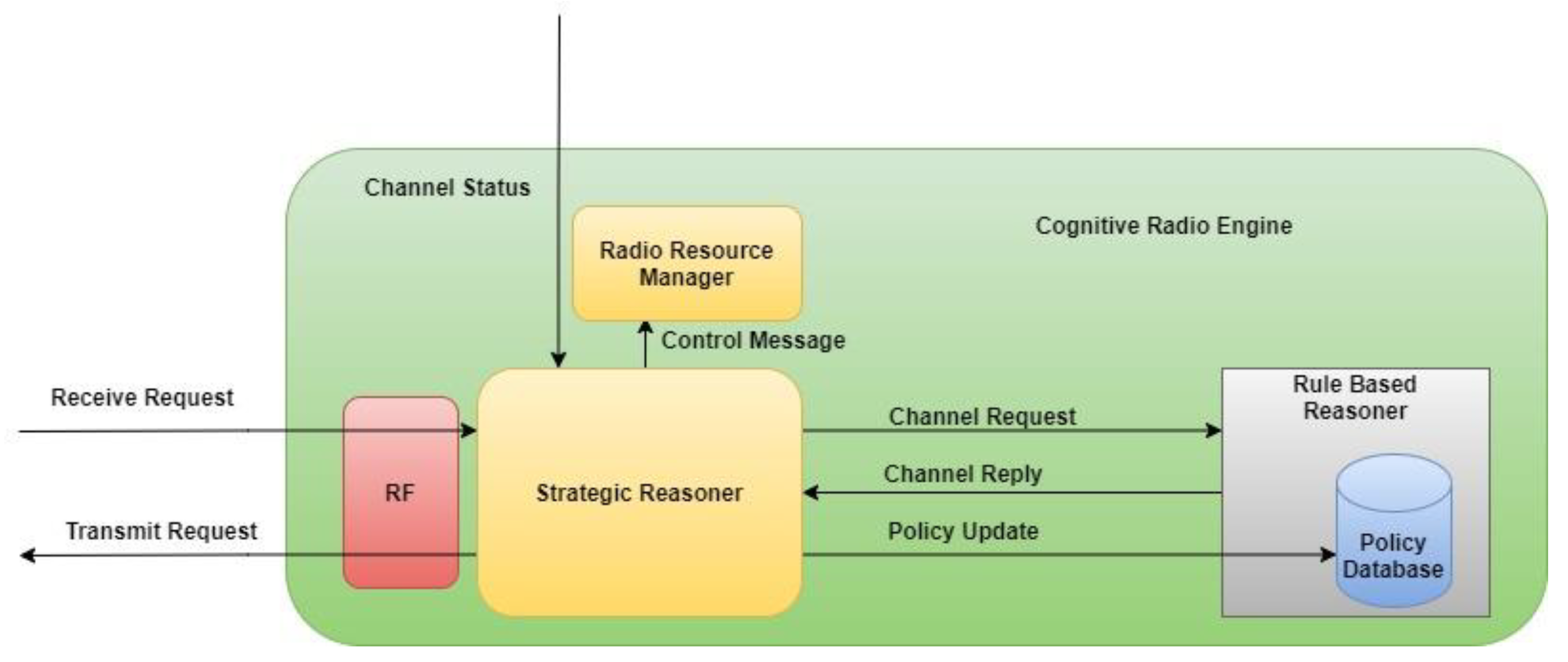
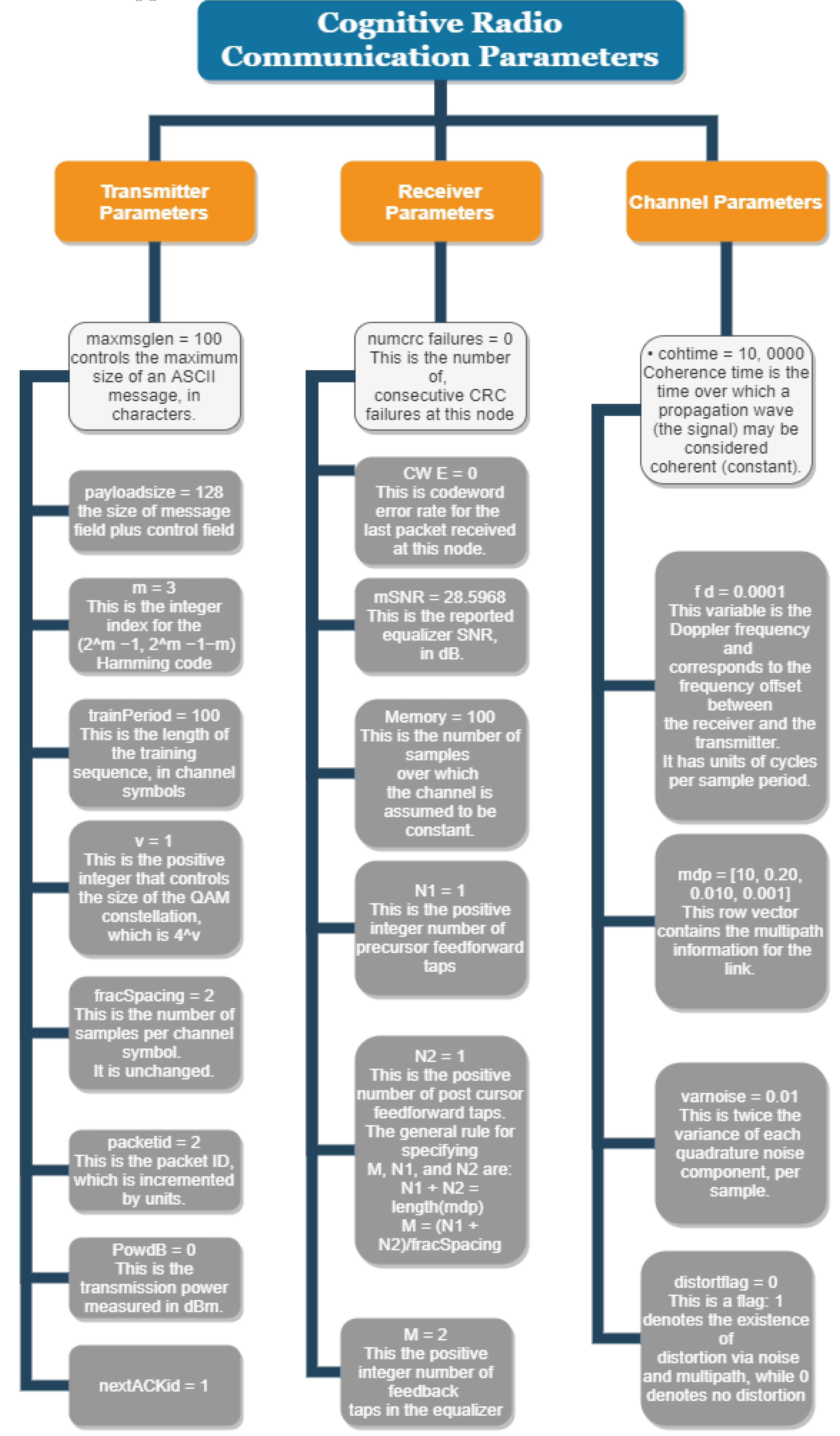


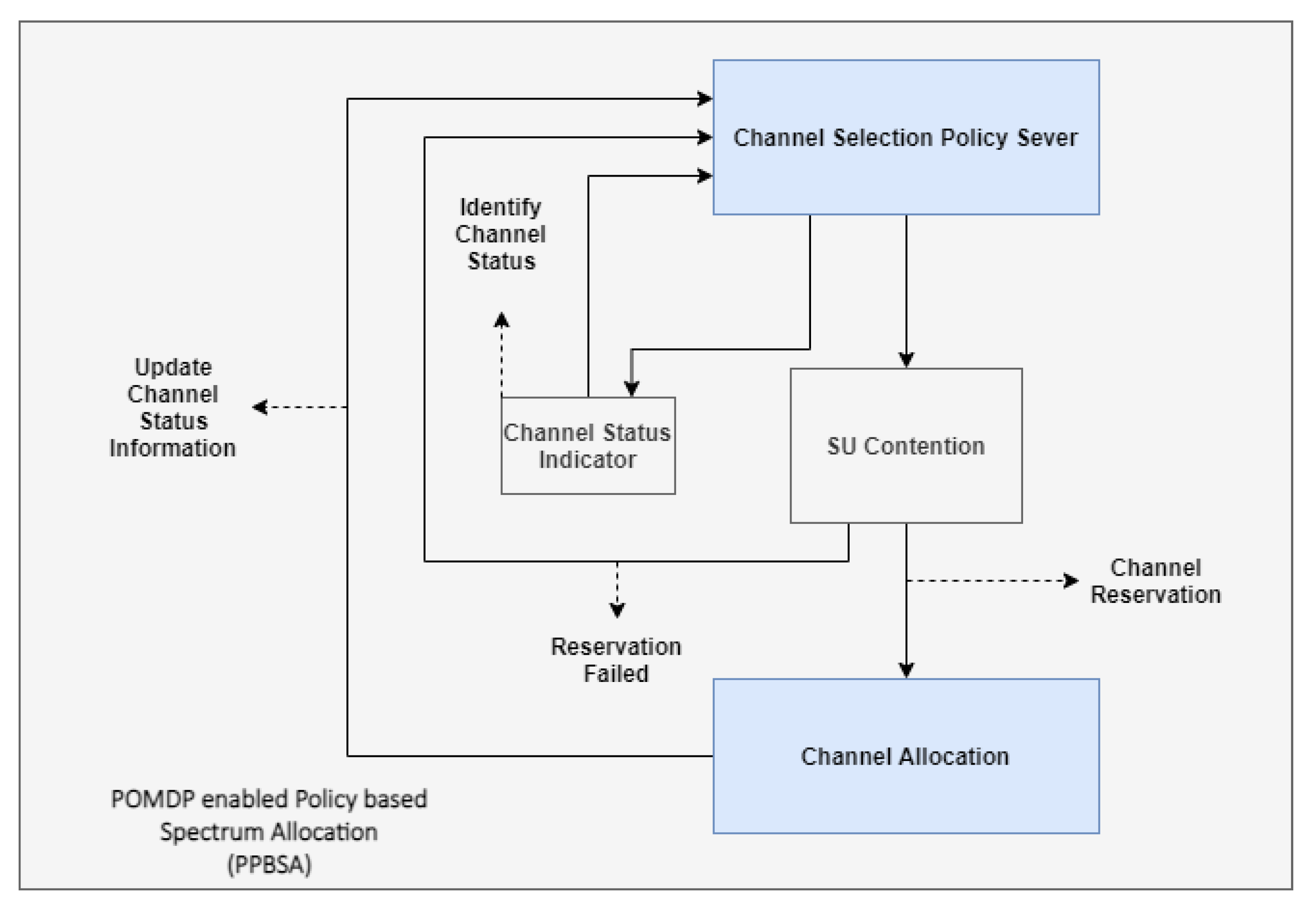
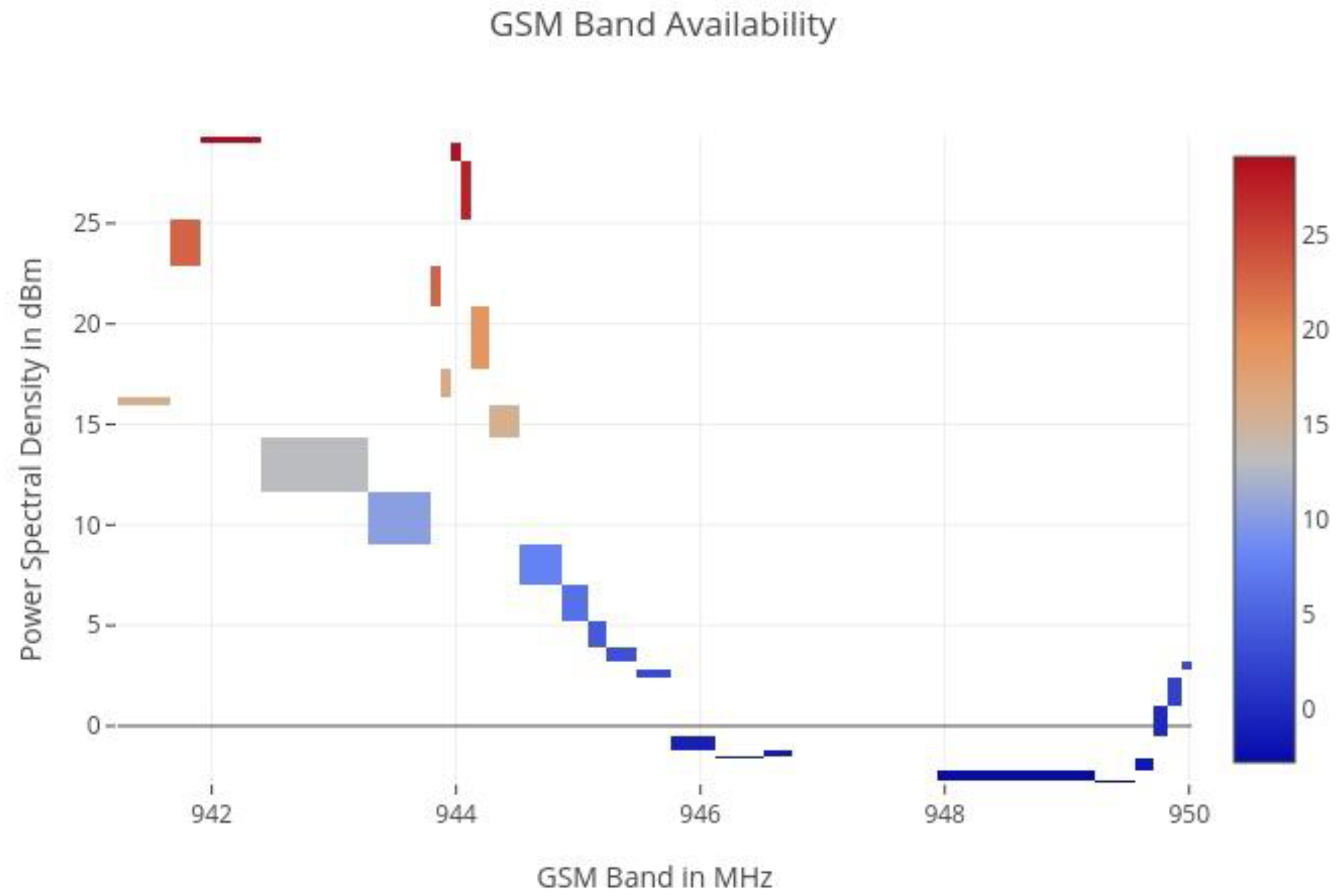
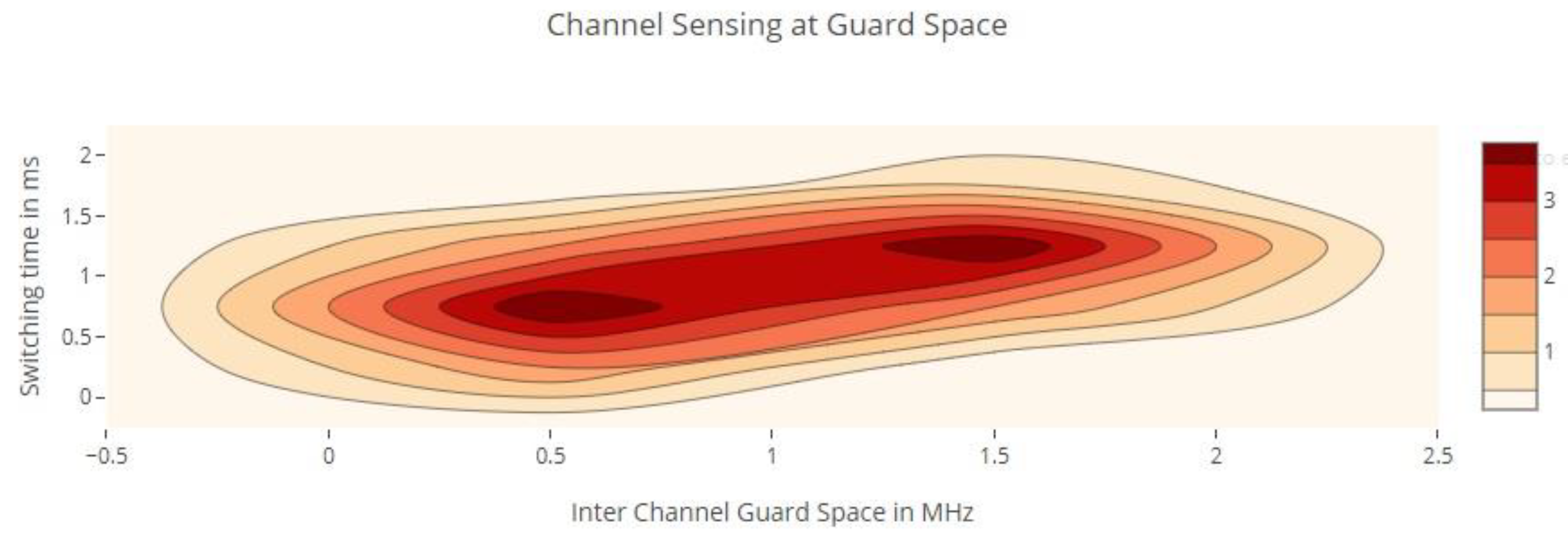
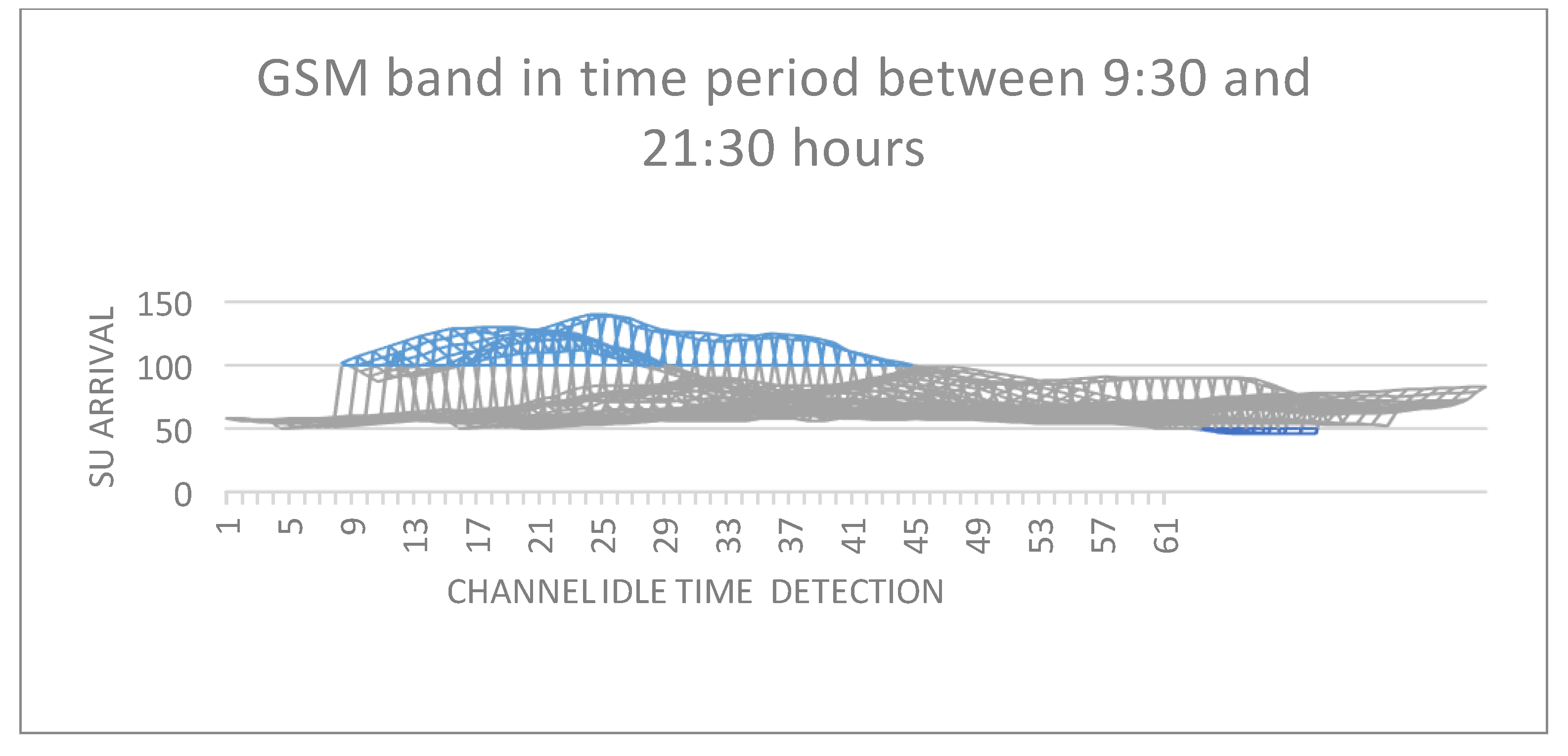
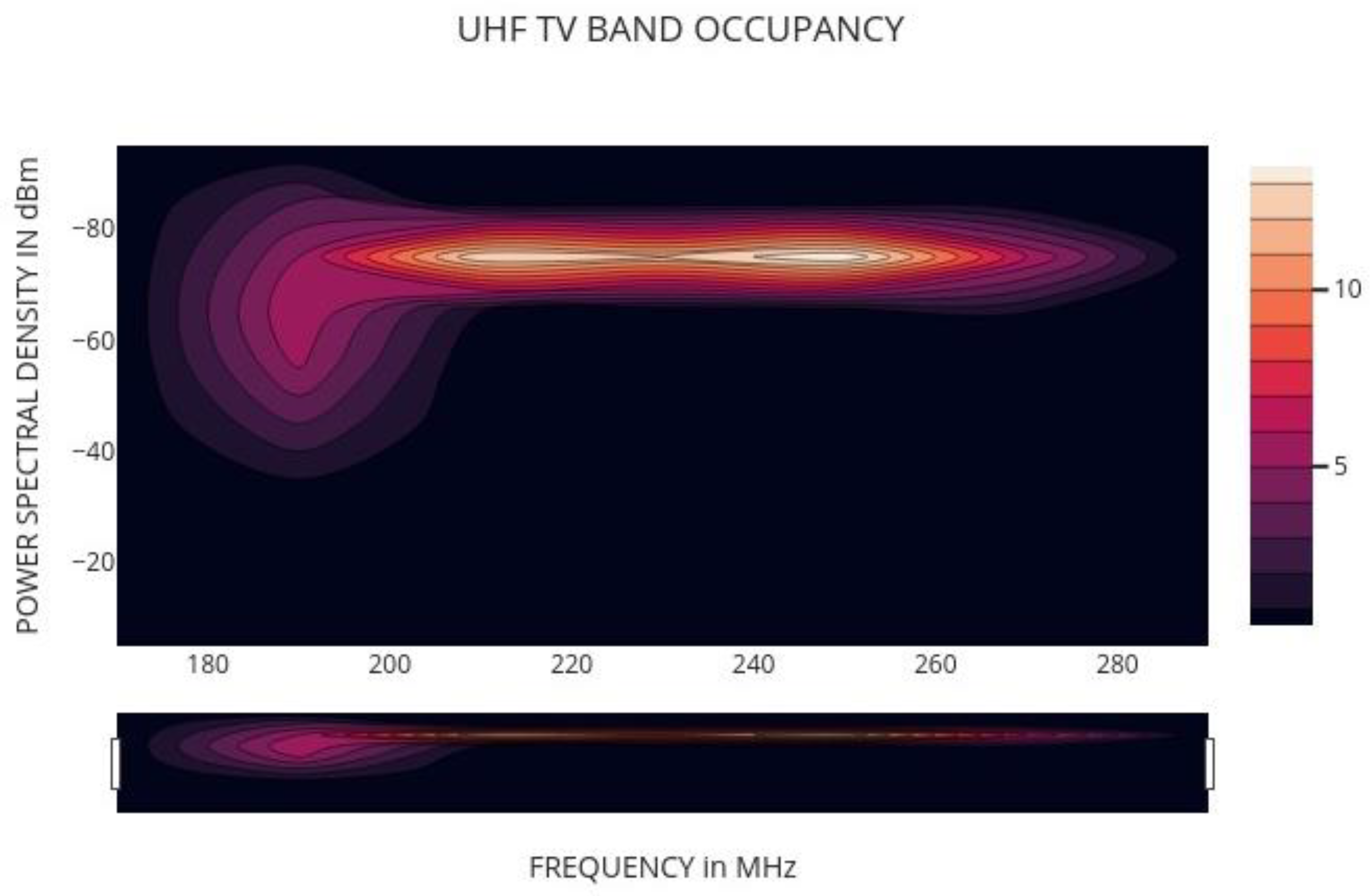
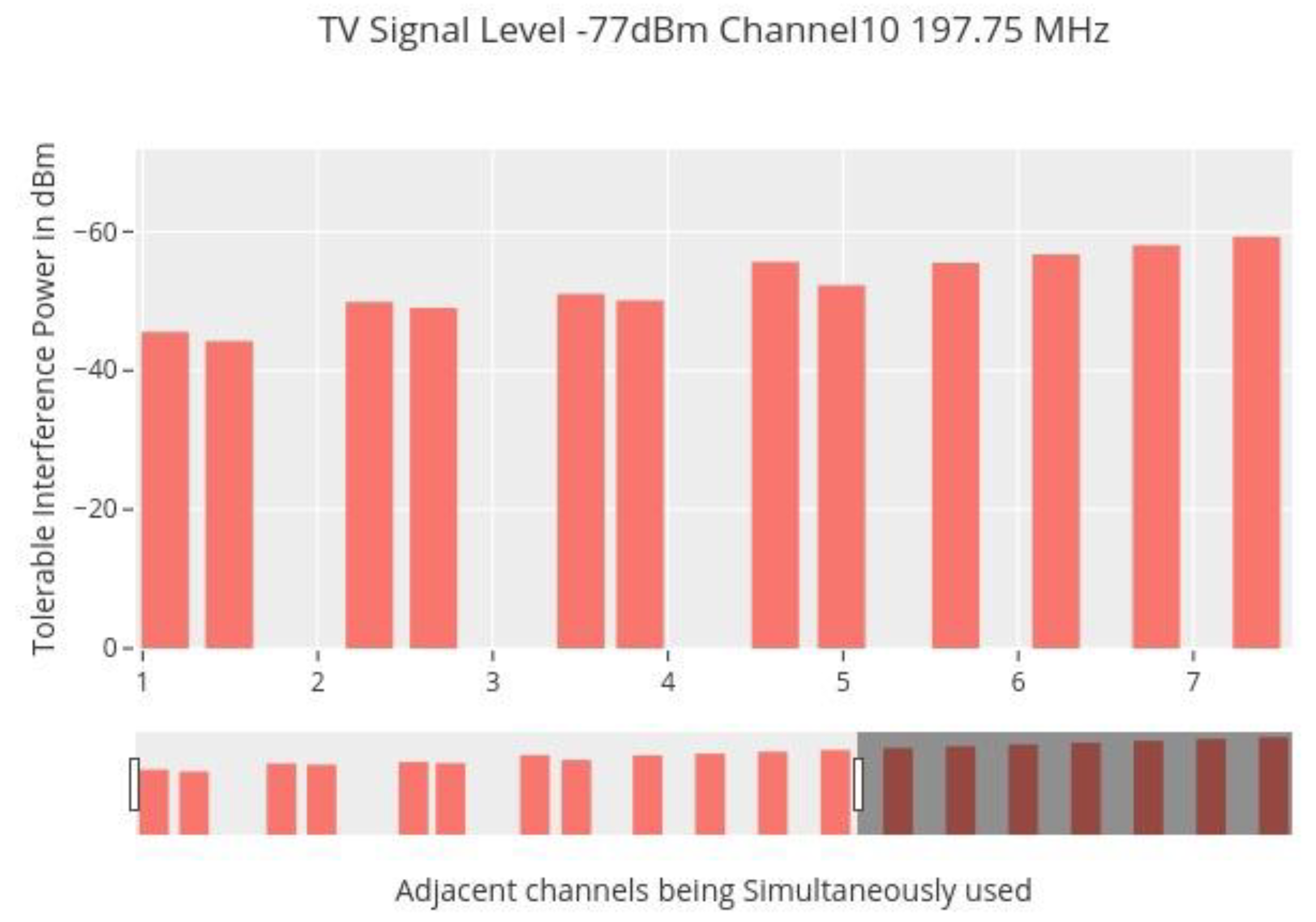

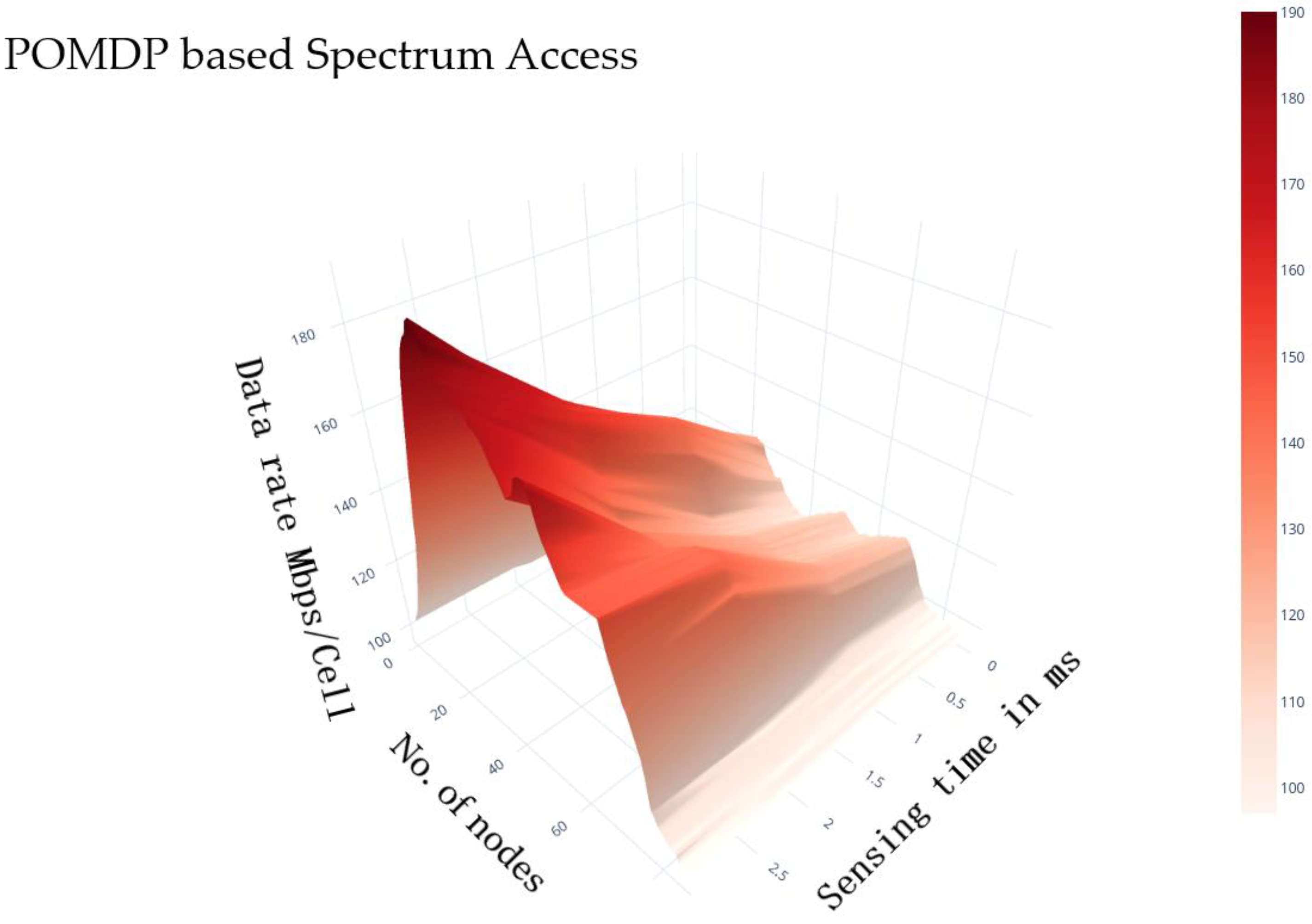
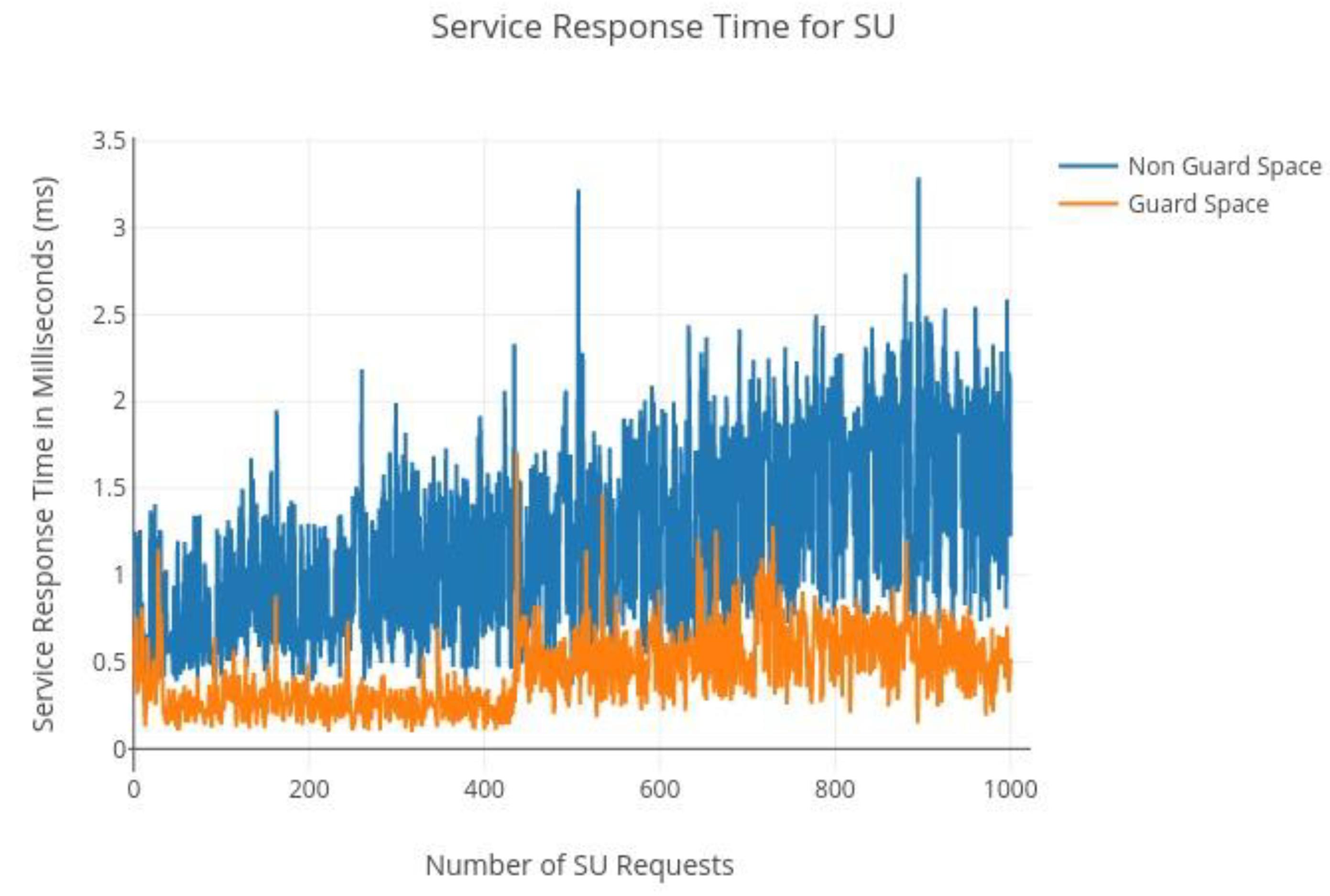
| Reference | Proposed Technique | Focus | Network | Simulation/Frequency Band | Parameters Improved |
|---|---|---|---|---|---|
| [1] | A detailed survey on spectrum sensing technique in 5G. | Sensing | Distributed | - | Spectrum trading and leasing Multi-user interference |
| [2] | A CR-enabled NOMA network capable of wireless data and power transmission at the same time. | Sensing | Distributed | 106 iterations Monte Carlo simulations | Power outage probability |
| [3] | One of SenPUI’s key issues, detecting and Primary User Interference, is addressed by a unique cognitive radio algorithm. | Sensing | Centralized | Real-time implementation with IEEE 802.15.4 | Throughput Primary User Interference |
| [4] | Models for analyzing and evaluating sharing procedures under a wide variety of situations were provided. | Sharing | Distributed | MATLAB | PU activity SU Arrival |
| [5] | In cognitive radio networks, the hidden Markov model (HMM) was used for opportunistic spectrum access (OSA) through cooperative spectrum sharing. | Sharing | Distributed | HMM in OSA | Detection Probability |
| [6] | The CR networks may now be made aware of the needs of unlicensed users through a new method that reduces sensing latency. | Sensing | Distributed | Q-learning for different radio access techniques | Sensing Latency |
| [7] | Two machine learning (ML) approaches that have been developed to increase spectrum sensing performance are k-nearest neighbors and random forest. | Policy | Distributed | Energy detection using k-NN and RF Algorithms | Energy Detection |
| [8] | Massive MIMO cognitive radio underlay user selection was proposed using a QoS-aware technique. | Policy | Distributed | Deployed a DNN with MIMO CR | Loss Function Success Rate Average transition time |
| PARAMETERS | ||
|---|---|---|
| Channel | Transmitter | Receiver |
| Doppler Frequency fd (0.0001) | ASCII message maximum size Maxmsglen (100) | Equalizer feedback tap number N1 |
| Multipath-Link Information mdp (10, 0.2, 0.001, 0.010) | Message + control message Payload (128 bits) | Equalizer feedforward tap number N2 |
| Variance of Quadrature noise varnoise (0.01) | Hamming code index M (3) | N1 + N2 = mdp length |
| Distortion Flag distort flag (0 for no distortion and 1 for noise) | Samples/Channel symbol Fracspace (2) | Fracspace (2) |
| Coherence Time Cohtime (100,000) | PacketID | Cohtime Memory |
| ACKID | ||
| Power in dBm maxpower | ||
| Cognitive Channel Allocation Policies | ||||
|---|---|---|---|---|
| Scenario | Pu is occupying the spectrum. SUs are in queue. | The spectrum is free, PU is idle and not utilizing the spectrum. SU is in need. | PU has left the spectrum free, No. of the competing SUs is more for the same spectrum. | PU has been left with a fading channel. Spectral density is low. The secondary user arrival rate is Poisson. |
| Policy | Wait | Allocate | Assign by Rank | Random wait |
| Reason | As the history of the PU activity and the requirement of the SU is known, mapping is already done, the mapping table is verified, and then policy 1 is triggered. | The spectrum is freed by PU. SU is in need of the spectrum. Spectral density is good. SU’s requirement lies within the availability of the spectrum. SU’s Qos is also satisfied by the network and spectrum parameters. | SUs are prioritized for their effective utilization of the spectrum and their active participation without wasting the spectrum. Their spectral density and utilization factor are the criteria for the decision. | The spectrum analyzer has to detect the quality of the channel by sending a few random packets at different time intervals. |
| Parameters | Range Setup 1 | Range Setup 2 | Range Setup 3 |
|---|---|---|---|
| Spectrum Frequency | 99 kHz–3 GHz | 100 MHz–1000 MHz (UHF) GSM 900 MHz 2.4–2.5 GHz (ISM band) | 50 MHz–4400 MHz [GSM 900, GSM 1800] |
| Duration | 12 h [6 a.m.–6 p.m.] | 24 h | 24 h |
| Instance | 60 | 90 | 120 |
| Sweep Time [Frequency Span = 0 Hz] | 1 millisecond–100 s | Auto | Auto |
| Sweep Time [Frequency Span > 0 Hz] | 20 milliseconds–1000 s | Auto | Auto |
| Bandwidth for Video | 10 Hz–1 MHz | 100 kHz | 10 MHz |
| Interface | RS232 | RS232 | RS232 |
| Bandwidth Resolution | 10 Hz–1 MHz | 100 kHz | 10 MHz |
Publisher’s Note: MDPI stays neutral with regard to jurisdictional claims in published maps and institutional affiliations. |
© 2022 by the authors. Licensee MDPI, Basel, Switzerland. This article is an open access article distributed under the terms and conditions of the Creative Commons Attribution (CC BY) license (https://creativecommons.org/licenses/by/4.0/).
Share and Cite
Babu, C.R.; Balakrishnan, A.; Ramana, K.; Singh, S.; Ra, I.-H. Elite-CAM: An Elite Channel Allocation and Mapping for Policy Engine over Cognitive Radio Technology in 5G. Sensors 2022, 22, 5011. https://doi.org/10.3390/s22135011
Babu CR, Balakrishnan A, Ramana K, Singh S, Ra I-H. Elite-CAM: An Elite Channel Allocation and Mapping for Policy Engine over Cognitive Radio Technology in 5G. Sensors. 2022; 22(13):5011. https://doi.org/10.3390/s22135011
Chicago/Turabian StyleBabu, C. Rajesh, Amutha Balakrishnan, Kadiyala Ramana, Saurabh Singh, and In-Ho Ra. 2022. "Elite-CAM: An Elite Channel Allocation and Mapping for Policy Engine over Cognitive Radio Technology in 5G" Sensors 22, no. 13: 5011. https://doi.org/10.3390/s22135011
APA StyleBabu, C. R., Balakrishnan, A., Ramana, K., Singh, S., & Ra, I.-H. (2022). Elite-CAM: An Elite Channel Allocation and Mapping for Policy Engine over Cognitive Radio Technology in 5G. Sensors, 22(13), 5011. https://doi.org/10.3390/s22135011







